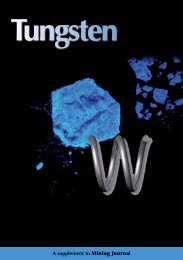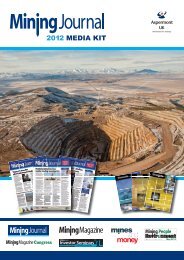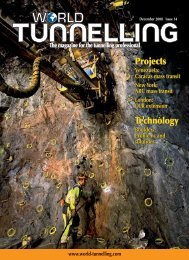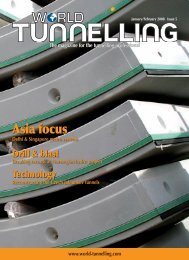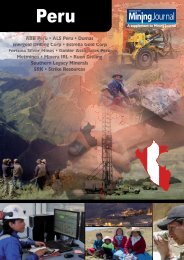Download Supplement PDF - Mining Journal
Download Supplement PDF - Mining Journal
Download Supplement PDF - Mining Journal
Create successful ePaper yourself
Turn your PDF publications into a flip-book with our unique Google optimized e-Paper software.
14<br />
EXPLORATION SPECIAL<br />
A Hydracore drill<br />
rig in operation in<br />
Guatemala<br />
<strong>Mining</strong> <strong>Journal</strong> special publication – PDAC<br />
• Tailings Dams<br />
the onsite team must ensure that they have access to<br />
a full inventory of spare parts and repair tools.<br />
Wear parts must be checked regularly and the<br />
company should promote equipment use that<br />
respects the clauses stated in the rig’s manufacturer<br />
warranty. This will help to optimise the equipment’s<br />
functionalities while also ensuring normal wear.<br />
Mr Slight says: “A strong understanding of the drill<br />
that you are working with is<br />
paramount. With this understanding,<br />
and training and support from<br />
the OEM, it is possible to<br />
implement a good maintenance<br />
programme, have the spares on<br />
hand should a fault occur, and keep<br />
down time to a minimum.”<br />
Mr Paquet says: “Some drills, like<br />
Fordia’s Golden Bear 1 400 S, have<br />
a simple mechanical design that<br />
allows for the replacement of<br />
important parts without the need<br />
for a technician or hydraulic<br />
engineer.”<br />
Nigel Spaxman, manager of Hydracore, adds:<br />
“Choosing a good-quality machine that utilises a<br />
simple and straightforward design will help to avoid<br />
unnecessary maintenance problems. If a rig is<br />
operated in accordance with the manufacturers’<br />
guidelines, the major components should last at least<br />
a year before an overhaul would be required.<br />
“Hydraulic systems on drill rigs are often much<br />
• Environmental Permitting<br />
• Specialty <strong>Mining</strong>-Tunneling<br />
• Geotechnical/Geomechanical<br />
Investigations<br />
• Hydrological & Hydrogeological<br />
Studies<br />
www.rizzoassoc.com<br />
“Taking time to<br />
check the rig over<br />
before and after a<br />
shift can<br />
significantly<br />
improve the<br />
chances that it will<br />
perform optimally”<br />
more complicated than is necessary. A load-sensing<br />
hydraulic system is not always required on a diamond<br />
drill, but most machines have them. Pumps and valves<br />
for these systems are expensive to replace and are<br />
often prone to failure. Staying away from electronically-controlled<br />
diesel engines is a good way to avoid<br />
problems too.”<br />
As with any mechanical issues, prevention is better<br />
than cure. Taking time to check the<br />
rig over before and after a shift can<br />
significantly improve the chances<br />
that it will perform optimally. Ms<br />
Overby explains: “During this time,<br />
the driller should thoroughly<br />
review the rig, looking for worn<br />
parts or anything out of the<br />
ordinary. The rig should also be<br />
cleaned, well-oiled and should<br />
receive regular services at planned<br />
intervals.<br />
“It is important for the driller<br />
to feel responsible for the rig;<br />
we have seen too many occasions<br />
when the responsibility of rig maintenance is passed<br />
from person to person and no-one takes ownership<br />
of the rig. It often leads to problems.”<br />
Avoiding common mistakes<br />
Rushing to buy a rig because a tender has been won,<br />
or choosing a model based on a quick delivery time,<br />
rather than for the purpose of the project are the<br />
Visit us at PDAC<br />
Booth 1145!<br />
February 2012




